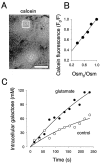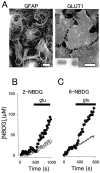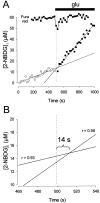Glutamate triggers rapid glucose transport stimulation in astrocytes as evidenced by real-time confocal microscopy
- PMID: 12917367
- PMCID: PMC6740433
- DOI: 10.1523/JNEUROSCI.23-19-07337.2003
Glutamate triggers rapid glucose transport stimulation in astrocytes as evidenced by real-time confocal microscopy
Abstract
Glutamate stimulates glycolysis in astrocytes, a phenomenon that couples astrocytic metabolism with neuronal activity. However, it is not known whether glutamate also affects glucose transporter-1 (GLUT1), the transporter responsible for glucose entry into astrocytes. To address this question, two different real-time single-cell hexose uptake assays were applied to cultured hippocampal astrocytes using confocal epifluorescence microscopy. Glutamate caused a twofold to threefold increase in the zero-trans uptake rates of the fluorescent hexoses 2-[N-(7-nitrobenz-2-oxa-1,3-diazol-4-yl)amino]-2-deoxyglucose (2-NBDG) and 6-[N-(7-nitrobenz-2-oxa-1,3-diazol-4-yl)amino]-6-deoxyglucose (6-NBDG). Galactose uptake, determined by the calcein volumetric assay, was stimulated to a similar extent, confirming the fluorescent hexose data, and also demonstrating that glutamate stimulation is a Vmax effect. Remarkably, glucose transport stimulation developed fully inside 10 sec, which is 100 times faster than acute stimulations of glucose transport in other cell types. Glutamate did not significantly affect the rate of 6-NBDG uptake by GLUT1-expressing epithelial Clone 9 cells, suggesting that an astrocyte-specific factor is required for transport stimulation. We conclude that glucose transport stimulation occurs early during astrocytic activation by glutamate, which provides a novel regulatory node to current models of brain energy metabolism. This mechanism should also be considered for the interpretation of functional imaging data based on hexoses.
Figures



Similar articles
-
Glutamate mediates acute glucose transport inhibition in hippocampal neurons.J Neurosci. 2004 Oct 27;24(43):9669-73. doi: 10.1523/JNEUROSCI.1882-04.2004. J Neurosci. 2004. PMID: 15509754 Free PMC article.
-
Higher transport and metabolism of glucose in astrocytes compared with neurons: a multiphoton study of hippocampal and cerebellar tissue slices.Cereb Cortex. 2014 Jan;24(1):222-31. doi: 10.1093/cercor/bhs309. Epub 2012 Oct 4. Cereb Cortex. 2014. PMID: 23042735
-
Glucose metabolism down-regulates the uptake of 6-(N-(7-nitrobenz-2-oxa-1,3-diazol-4-yl)amino)-2-deoxyglucose (6-NBDG) mediated by glucose transporter 1 isoform (GLUT1): theory and simulations using the symmetric four-state carrier model.J Neurochem. 2013 Apr;125(2):236-46. doi: 10.1111/jnc.12164. Epub 2013 Feb 27. J Neurochem. 2013. PMID: 23336592 Free PMC article.
-
Aberrant Uptake of a Fluorescent L-Glucose Analogue (fLG) into Tumor Cells Expressing Malignant Phenotypes.Biol Pharm Bull. 2018;41(10):1508-1516. doi: 10.1248/bpb.b18-00089. Biol Pharm Bull. 2018. PMID: 30270319 Review.
-
Cellular mechanisms of brain energy metabolism and their relevance to functional brain imaging.Philos Trans R Soc Lond B Biol Sci. 1999 Jul 29;354(1387):1155-63. doi: 10.1098/rstb.1999.0471. Philos Trans R Soc Lond B Biol Sci. 1999. PMID: 10466143 Free PMC article. Review.
Cited by
-
Pinocembrin attenuates hemorrhagic transformation after delayed t-PA treatment in thromboembolic stroke rats by regulating endogenous metabolites.Acta Pharmacol Sin. 2021 Aug;42(8):1223-1234. doi: 10.1038/s41401-021-00664-x. Epub 2021 Apr 15. Acta Pharmacol Sin. 2021. PMID: 33859344 Free PMC article.
-
L-Lactate-Mediated Neuroprotection against Glutamate-Induced Excitotoxicity Requires ARALAR/AGC1.J Neurosci. 2016 Apr 20;36(16):4443-56. doi: 10.1523/JNEUROSCI.3691-15.2016. J Neurosci. 2016. PMID: 27098689 Free PMC article.
-
High resolution measurement of the glycolytic rate.Front Neuroenergetics. 2010 Sep 15;2:26. doi: 10.3389/fnene.2010.00026. eCollection 2010. Front Neuroenergetics. 2010. PMID: 20890447 Free PMC article.
-
Astrocytes generate Na+-mediated metabolic waves.Proc Natl Acad Sci U S A. 2004 Oct 12;101(41):14937-42. doi: 10.1073/pnas.0405315101. Epub 2004 Oct 4. Proc Natl Acad Sci U S A. 2004. PMID: 15466714 Free PMC article.
-
Glucosamine-bound near-infrared fluorescent probes with lysosomal specificity for breast tumor imaging.Neoplasia. 2008 Apr;10(4):389-98. doi: 10.1593/neo.07856. Neoplasia. 2008. PMID: 18392136 Free PMC article.
References
-
- Abbud W, Habinowski S, Zhang JZ, Kendrew J, Elkairi FS, Kemp BE, Witters LA, Ismail-Beigi F ( 2000) Stimulation of AMP-activated protein kinase (AMPK) is associated with enhancement of Glut1-mediated glucose transport. Arch Biochem Biophys 380: 347-352. - PubMed
-
- Alvarez A, Toro R, Caceres A, Maccioni RB ( 1999) Inhibition of tau phosphorylating protein kinase cdk5 prevents beta-amyloid-induced neuronal death. FEBS Lett 459: 421-426. - PubMed
-
- Baldwin SA, Barros LF, Griffiths M, Ingram J, Robbins EC, Streets AJ, Saklatvala J ( 1997) Regulation of GLUT1 in response to cellular stress. Biochem Soc Trans 25: 954-958. - PubMed
-
- Ball SW, Bailey JR, Stewart JM, Vogels CM, Westcott SA ( 2002) A fluorescent compound for glucose uptake measurements in isolated rat cardiomyocytes. Can J Physiol Pharmacol 80: 205-209. - PubMed
-
- Barnes K, Ingram JC, Porras OH, Barros LF, Hudson ER, Fryer LG, Foufelle F, Carling D, Hardie DG, Baldwin SA ( 2002) Activation of GLUT1 by metabolic and osmotic stress: potential involvement of AMP-activated protein kinase (AMPK). J Cell Sci 115: 2433-2442. - PubMed
Publication types
MeSH terms
Substances
LinkOut - more resources
Full Text Sources
Other Literature Sources
Miscellaneous
